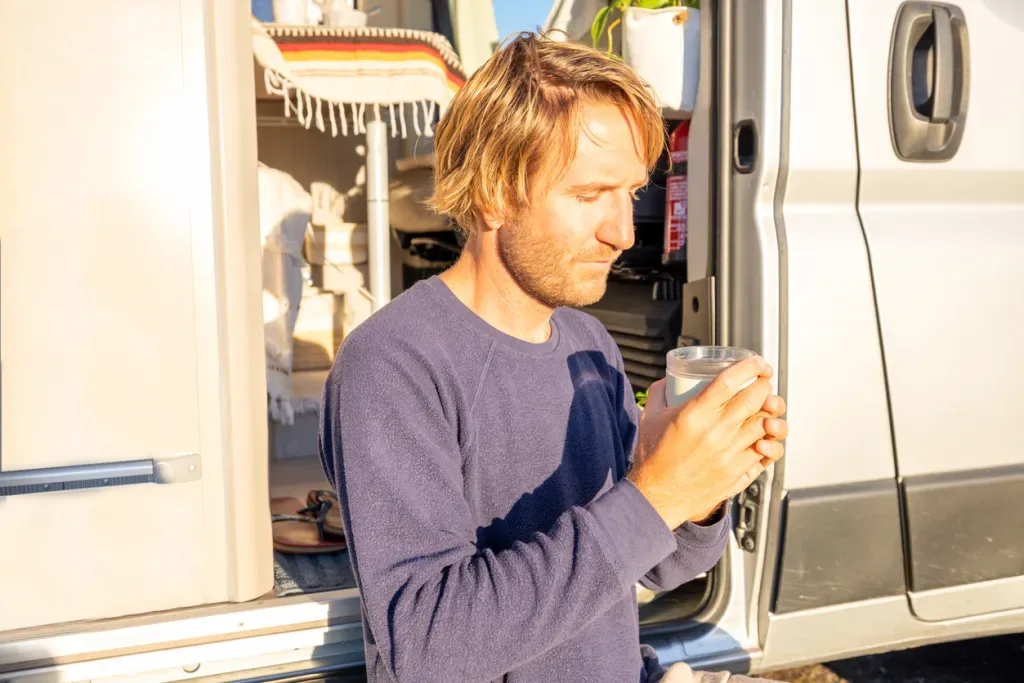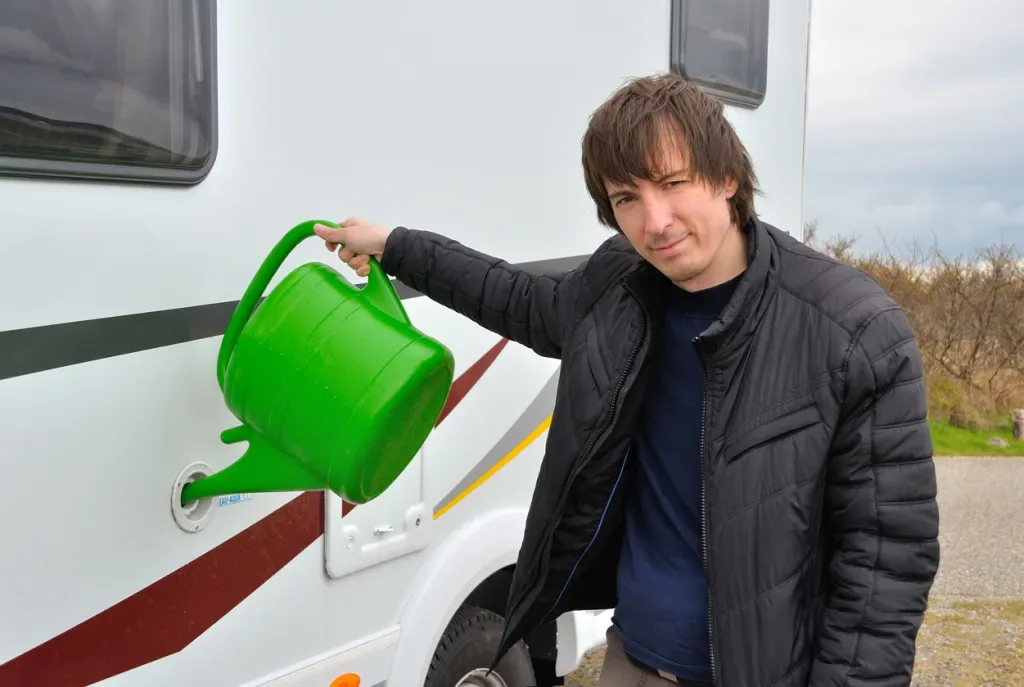Despite the name, a drink from an RV freshwater tank may not be as clean as you think. In fact, sometimes, it’s downright gross.
If you ignore some critical maintenance, a glass may give you more than a bad taste in your mouth.
Today we’ll discuss just how sanitary your tank is and go over ways you can improve your setup.
Let’s hit it!

What Is an RV Freshwater Tank?
The freshwater tank is what makes it possible to drink, clean, and shower in your RV. You can fill up at home before leaving or brave the water connections you find along the way.
As it goes down the drain, it heads to your gray water tank. The one exception is waste from the toilet, which goes to the black water line. This plumbing system makes life on the road much more comfortable, but they all require routine maintenance. They also rely on a pump to maintain consistent pressure.
Your plumbing equipment starts and ends with the cisterns found on the underside of your rig. It’s crucial to know how they work and how to give them the proper love to keep your family safe during your travels.
Is It Safe To Drink Water From Your RV Freshwater Tank?
You can safely drink from an RV freshwater tank, but you have to follow some essential safety tips before filling your glass.
Although the H20 may start to clean from the tap, there are many ways you can accidentally contaminate it. First of all, you’ll need a hose that’s rated for drinking water. Make sure the materials are high quality, won’t break down in the sun, and have lead-free fittings.
Of course, you must keep it separate from the ones you use for your waste tanks. These lines will collect all sorts of gunk you don’t want to drink.
While you can generally trust your tap water at home, the same isn’t always true of the supply at campsites. Make sure you have a potable source before you fill up. You can also consider adding a filter to your hose to keep sediment out of your plumbing.
Additionally, you must sanitize your hose between uses to keep bacteria at bay. You can find hose sanitizer from your local hardware store. Simply follow the directions, and you can stay safe.
And that goes for your freshwater tank as well.
Find Out: Is Your RV Fresh Tank Clean? (Probably Not).
How Often Should You Sanitize Your RV Freshwater Tank?
If it’s been a while since you’ve filled up, your drink may pick up a funky taste or smell. This is a sign that you should drain and sanitize your RV’s freshwater tank.
Even if nothing seems off, it’s a good idea for full-timers to clean it every six months. You should also empty it between trips and not leave anything sitting in it for extended periods.
The process is simple, but it takes about 12 hours. You’ll need to drain everything and make a solution with one-quarter cup of bleach for every 15 gallons it holds. You can also use vinegar or purchase a premade mix at an RV supply store.
Make sure you empty and bypass your water heater, too.
Does Drinking Water From an RV Freshwater Tank Taste Funny?
H20 absorbs things well. If your tank has something funky, like mildew, you’ll notice the tang when you drink it.
If you recently filled up and everything is sanitized, it can still taste stale. That’s because of air in the tank dissolving into the water. Luckily you can find several kinds of filters to help get a better taste. An under-sink or countertop carbon block can remove odors and funky flavors.
You can also use a pitcher-style purifier. These are popular because of how simple they are. Once you fill it up, it fits right in your fridge. But it’s important to note that most won’t remove germs from the water.
If you’re ever in doubt, you can always boil it for a few minutes to kill bacteria or viruses. As long as it’s clear, it should be safe to drink.
How To Prepare To Drink From Your RV Freshwater Tank
Getting a tasty glass of fresh water from your RV tank is simple if you follow this process. While it does take some time, it’s well worth it.
Sanitize Your RV Freshwater Tank
Start by adding the correct amount of solution to your freshwater tank. Then top it off with the tap.
Next, you’ll want to turn on all the faucets one at a time until you smell the solution, then turn them off. This’ll ensure that you sanitize every part of the plumbing.
Ideally, you’ll let it sit for 12 hours. But if you’re running short on time, it needs a minimum of six to eight hours. After it takes effect, drain the tank until it’s empty. Next, flush out all the lines to rinse the solution out. You’ll need to fill it up several times to rinse everything thoroughly.
Some people use store-bought sanitizers like STAR BRITE Aqua Water Tank & System Flush.
Fill Your RV Water Tank
Start with a clean drinking water hose. Attach one end to the intake valve on your freshwater tank and the other to the supply line. If you’re filling up from a campground, make sure it’s potable before you turn it on.
It’s a good idea to attach a pressure regulator to the hose. This’ll prevent damage to your plumbing if the spigot is too powerful. Once everything is connected, turn the supply on and wait until your tank’s full.
An inline sediment filter can protect your plumbing from dirt and sand. However, save the carbon block for later. It’s better to leave chlorine in the water while it sits in your tank to prevent mold and mildew.

Use Additional Filtration Devices for Drinking Water
For the best-tasting water, find a good point-of-use filter for your kitchen sink. You can attach a countertop unit directly to the faucet. Or you can find a pitcher-style purifier and fill it up as needed.
This makes a huge difference in the taste and quality of your drink, especially if you’re using the water at a campground.
Why would you? But just in case: 5 Reasons To Avoid Drinking from the Water Hose.
Stay Hydrated with a Clean Freshwater Tank
Keeping your freshwater tank clean is essential to having a safe drink in your RV. Buying the bottled stuff is an expensive hassle that’s not worth it in the long run.
If you follow the sanitation protocol and use a filter, you’ll have the same quality without wasting money and plastic. You’ll also avoid the funky tastes and smells that come with an unclean tank!
Discover the Best Free Camping Across the USA
To be honest with you, we hate paying for camping. There are so many free campsites in America (with complete privacy).
You should give it a try!
As a matter of fact, these free campsites are yours. Every time you pay federal taxes, you’re contributing to these lands.
Become a FREE CAMPING INSIDER and join the 100,000 campers who love to score the best site!
We’ll send you the 50 Best Free Campsites in the USA (one per state). Access the list by submitting your email below: